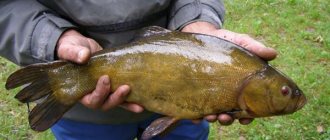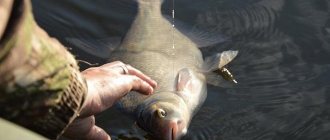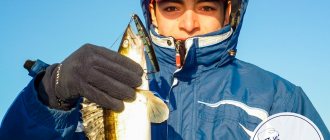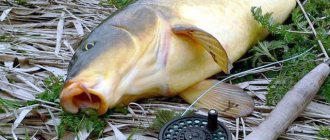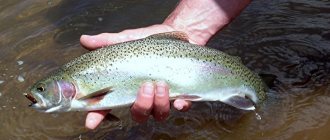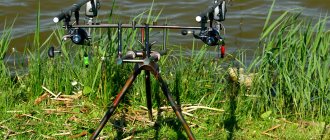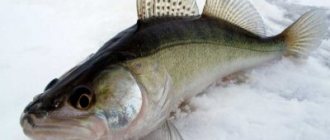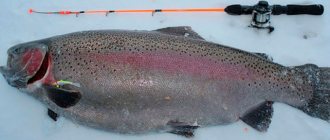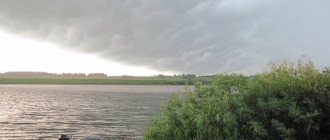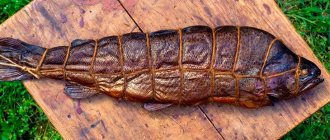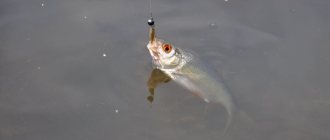Trout fishing is undeniably becoming more accessible every day. What contributes to this is not the improvement of the ecological situation, which, of course, would be desirable to a greater extent, allowing this fish, which loves crystal clear water, to reproduce, conquering more and more new bodies of water suitable for habitation, but the creation of artificial ponds populated with river trout for commercial fishing. For most fishermen, catching trout in natural conditions remains only a cherished desire, which can be fulfilled far from places of active human activity.
Well, if there is still a choice of fishing places that provide such opportunities, then sooner or later the fisherman, due to his curiosity and replenishment of the list of trophy fish, will master this interesting technique with its nuances and secrets, which will be facilitated by his familiarization with the information presented in the article below, telling what is the best way to catch trout depending on the method of hunting and the season of the year.
About trout
Trout fishing is not complete without knowing basic information about this fish, which seems to be widely known to any average person, but this does not make it a more common trophy in the catches of most anglers. Trout is a bright representative of the salmon family, which has a huge number of species living in fresh waters. Due to their place of residence, the population is divided into river and lake forms, which, by the way, easily adapt to the lifestyle when changing the area without any consequences for themselves, flowing from one subspecies to another.
Trout or brown trout are cold-loving species that prefer to live in waters with temperatures not exceeding 20 degrees. Also, fish are sensitive to the saturation of water with oxygen and the presence of all kinds of suspended matter that reduces the transparency of water, thus becoming a natural indicator of the cleanliness of any body of water. The average size of the fish is about 40 cm with a weight of 0.7-1 kg. Larger specimens, both when fishing for brook trout and lake trout, are rightfully considered trophy and are caught quite rarely in catches.
Features of trout fishing
Trout fishing has three main directions. The simplest and most inexpensive method is float fishing . To hunt for a trophy using a fishing rod, there is no need to master special fishing techniques or buy rare baits. Fishing by fly fishing is considered a complex and expensive method. Fly fishing gear for trout fishing, as well as lures of this type, have their own specific configuration and production, belong to one of the elite areas of fishing and require mandatory acquisition of skills for the technical execution of techniques for presenting bait and performing retrieves.
Spinning fishing is a type intermediate in technical complexity between float and fly fishing and, apparently, this is why the method has many fans, especially in commercial pond trout fishing. Recently, special attention has also been paid to the direction of feeder fishing, which is especially successful in the pre-winter period when the predator moves to the depths.
Trout fishing gear
trout is a versatile fish in terms of the choice of gear, so a wide variety of gear can be used to catch trout. The main gear for trout fishing is:
- spinning;
- float rod;
- fly fishing
All of these 3 types of tackle are excellent for trout fishing and do the job just as well. Each angler can choose his own tackle for trout, which lies closer to his heart and, of course, the tackle with which he already has some fishing experience. Well, in general, it would not hurt any fisherman to try all these 3 trout fishing tackles that I have listed in order to feel the beauty of fishing with each of them.
Of course, the entire subsequent course of fishing will depend on the choice of gear. Each tackle has its own method, method and principle of trout fishing, and of course the bait for each tackle will be completely different.
When to catch trout
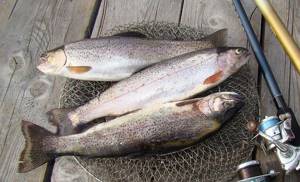
Trout fishing begins with the disappearance of ice from the surface of reservoirs. Melt water activates the fish, which begins to gain lost mass after the winter hungry period. Until the water warms up significantly, and this period lasts until the beginning of June, the bite is relatively stable and is especially good in the afternoon. In summer, the intensity of bites noticeably decreases, and the predator is active only in the early morning, in cool water. In a mountain river where the flow is fed with meltwater throughout the summer, fish will be active throughout the day.
With the arrival of autumn, the most active phase of fishing for this fish begins . The cooling of the water gives a signal for the start of preparation for spawning, and the fish begin to fatten, starting to feed around the clock, including their dark time. The spawn itself is distinguished by a pause in feeding, after which there is a transition to the winter season of the relatively passive behavior of the predator.
Important! Trout does not like prolonged rains, which bring turbidity to the water and reduce atmospheric pressure.
Stable weather with constant atmospheric pressure and lack of precipitation for three or four days gives a good chance for a stable and intense bite.
Where to fish
You can catch trout in natural conditions on the rapids of mountain rivers and in cool streams, as well as in lakes, into which these cold streams and rivers, fed throughout the year with melt water, directly flow. Under natural conditions, the predator prefers to stay in a small flock on the currents themselves or in border waters, guarding insects falling on the water or passing food objects in the water column.
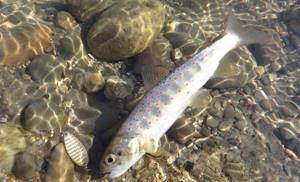
Larger individuals go to depths in relatively calm waters, hunting from ambush in the form of bottom anomalies, hiding behind boulders and in snags. The fish can stand in mid-water under steep cliffs and the crowns of trees overhanging the water, rising to the surface for food falling on the water.
Important! When choosing places on rivers, they focus on fast currents; when hunting on lakes, they look for bottom anomalies.
Artificial water structures are also not ignored. The predator is especially attracted to bridge supports, behind which the fish stand in schools, snatching fry and drowning carrion of insects from the rapids of the main current. In artificial conditions, for paid fishing, fish are bred in ponds, where solid bottom foundations are replete with small differences in depth, providing predators with places to hide and hunt.
Where and how to catch trout
Trout is found in fast mountain rivers, which are more like wide streams, in small mountain lakes, where besides trout there is no other fish, except perhaps grayling, and in large lakes, where in addition to trout there are many different fish.
Trout is a very cautious and timid fish; it can be scared off by the voice, silhouette of a fisherman and any sounds and rustles, not to mention the noise during catching and landing fish. Trout will certainly run away to a quieter place if the angler moves noisily along the shore. When fishing for trout, it is very important to wear camouflage clothing to blend into the background you will be standing against. It is necessary to sneak up on trout very carefully, and if you do this on a river where there is a current, it is better to do it against it, since the trout mainly stands with its head against the current and will not be able to see the angler sneaking from behind.
When fishing for brook trout in the current, you should choose places where it is stronger and where the water is cooler and saturated with oxygen. This is the kind of water that trout love. The water temperature at the fishing site should not exceed 20°C, otherwise the trout will be less active and its bite will worsen.
In summer, trout like to stay in schools in fast currents, or on the border between slow and fast currents. It can be found behind the boulders lying in the water, which the current bends around. Trout like to rest there after continuously fighting the fast current. Larger trout choose deeper sections of the river with various shelters in the form of fallen trees or the like. Large trout like to stand near steep, steep banks and in places with sharp changes in depth.
Most often, trout stay in the water floor, from where they make throws at small fish swimming past or insects that have fallen to the surface of the water. But often trout can be found at the very surface of a reservoir or, on the contrary, at the very bottom.
In general, we can briefly describe the habitats of trout as follows: places near bridges, rapids, sections of the river under waterfalls, estuaries, whirlpools and whirlpools, holes and depths with cool water, where there are shelters where it can quickly escape in case of danger.
Bait for trout
Trout bait should smell like fishmeal, shrimp or squid. It is desirable that this bait be active, that is, it needs to create a kind of turbidity and raise a cloud of dust. For this effect, you can use special geyser additives or simply add floating elements to the bait for trout. There is also a special pellet for trout, which can not only be used to feed fish, but also be used as bait.
Also, trout can be attracted even by the color of the bait! Trout are very attracted to bright colors, so it is advisable to add some bright dye to the trout bait to enhance its effect.
Many fishermen have not even thought about the issue of feeding trout, while others have made it a habit to feed trout and because of this they achieve better results. By feeding trout regularly in the same place, you will provide yourself with a promising place for trout fishing. First, you need to feed the trout every hour, luring it to a certain place, and then the frequency of feeding is gradually reduced to once a day, and then to several times a week. But this scheme is suitable, of course, only when you regularly catch trout in the same body of water. Find out more about trout bait.
Trout fishing gear
Trout fishing is provided by a set of gear made from universal tools and materials available to the fisherman at each fishing retail outlet. Only when assembling fly fishing gear can some difficulties arise, requiring narrow specific knowledge regarding both the rods themselves and the composition of the cords. In further information, the angler will be presented with directions for choosing various gear for trout fishing, ensuring the catch of a predator in natural conditions and in the conditions of a paid pond.
Spinning
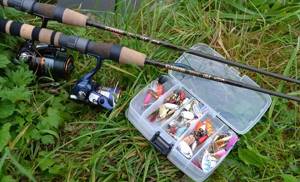
Trout fishing in the fall is most successful using spinning rods. The fish, starting to actively feed, becomes an energetic and sharp predator with aggressive behavior, sensitively responding to the placement of artificial baits in different water horizons. For fishing, spinning rods of semi-fast and fast action are selected. Ultralight tackle and tackle for supplying baits of 15–20 grams are optimal for catching predators according to their test characteristics. Since fishing can be done from boats and shorelines, spinning rod lengths vary from 1.7 to 2.3 meters when fishing from a floating craft, and for the shore, with the expectation of long-distance fishing, fishing rods with a length of 2.5 to 3.2 meters are used .
Lake trout fishing, like brook trout fishing, is universal in the selection of spinning equipment, which includes spinning reels with a high gear ratio and braided cords of small diameters, rarely exceeding a thickness of 0.15 mm. Wary fish require delicate rigs that are not overloaded with accessories in the form of ineffective leashes and bulky fasteners that make the rigs rougher and, therefore, less attractive to predators. Spinning fishing is done using wobblers, spinners and silicone baits. In some cases, it is rational to use live fry, fish fillets and pastes specially prepared for trout fishing.
Fly fishing
Trout fishing in mountain rivers and fast streams is the domain of fly fishing equipment. For fly fishing, a lightweight prefabricated fishing rod up to 2.5 meters long is equipped with an inertial reel with a reliable braking system. The volume of the reel should allow it to accommodate the main thick cord and its working part, which is selected depending on the fishing conditions and the use of the bait in a floating or sinking version.
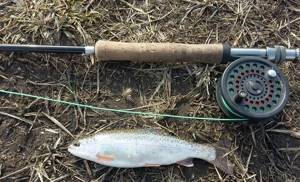
It is difficult to catch trout in winter or autumn with fly fishing, since the fish goes to the bottom horizons, where they mainly feed, but at the end of spring and throughout the summer season, especially when the mayfly emerges, this type of hunting is considered the most promising. Fly fishing is done in a wade, so as additional equipment, the angler will need to purchase waders or a floating raft, which make fishing not only more comfortable, but also much more successful in terms of choosing promising points and camouflaging the angler himself.
Important! The main lures in fly fishing are artificial dry and wet flies.
Also quite often, and it is especially effective to do this after their flight, natural insects are used.
Float rod
An effective fishing method is a float rod, or rather, a Bolognese version of this type of tackle, equipped with an inertial reel with a large drum, which allows fishing with bait swims over long distances. Telescopic fishing rods 6-7 meters long are selected from the lightest materials, graphite or carbon fiber. For fishing, a braided cord with a thickness of 0.10-0.12 mm is used at the end with a meter-long nylon leash of 0.12-0.14 mm. Hooks for trout fishing are selected based on the type of bait. Most of the selected accessories have an elongated fore-end with hook numbers from 10 to 14.
Important! They are caught with float tackle in the spring months and throughout the entire autumn season, when the predator switches to feeding in the middle water horizons.
Plant and animal baits are used as bait. Under some conditions, the predator can also be caught using wet artificial flies.
Feeder
The feeder is not as popular as all the hunting methods described above, but its effectiveness deservedly needs to be discussed during the pre-winter period, when the predator goes to the deepest points of reservoirs, which is especially important for paid ponds. For fishing, rods with a length of 2.8 -3.5 meters are used, with test parameters no higher than 50 grams. Choosing the right bait with the ability to boil and create a distinct spot of turbidity attracts predators from afar, making fishing from the bottom quite successful. The rigs are knitted from monofilament, using nylon or transparent fluorocarbon leashes one meter long in the rig, equipping the hooks with animal baits or a bright and fragrant paste.
First observations
For several years I learned the basics of catching these wary fish with a fishing rod. Then rumors began to appear that they could also be caught using spinning rods. At first I couldn’t believe it - after all, the information was leaking from Poland. A little later, after trying to catch trout with a spinning rod, I completely abandoned the float rod. The spinner's path was thorny. At that time, there was no real information on spinning fishing for trout and grayling, and it was necessary to “reinvent the wheel,” as it were. I had to make the spinners myself, and after a couple of years I already had very catchy baits in my arsenal that had passed numerous tests. Even treble hooks were initially made from elastic steel wire. These treble hooks were barbless, but they caught trout perfectly even without hooking. When “Mepps” appeared, we switched to them, but it soon became clear that our homemade products were not only not inferior to their “thoroughbred” brothers, but even superior to them.

Then there was a passion for wobblers. At first, they also had to be made independently, before decent branded ones appeared. In the process of experiments with baits, many interesting patterns were obtained, but some missing link was missing. Through trial and error over several seasons, it turned out that a wobbler is most effective in winter, spring and autumn, and a spinner is most effective in summer. Everything seems clear, but for some reason failures constantly occur. There are days when all the signs of a bite are evident, but the fish still doesn’t take it. For example, summer, early morning before sunrise, fog in the meadow, but no bite.
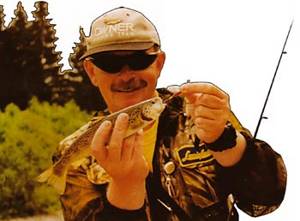
Some 3-4 hours pass, the sun is already quite hot, its direct rays penetrate the river, and suddenly the gluttony begins! The fish seems to have gone mad - it grabs all the bait indiscriminately. This lasts for about an hour, and that’s all... How the river died out. You wait for the evening, hoping to fish at sunset and see the fabulous bite again. NA no. On the way home, thoughts swirl in my head about why this happened. It seems like there is no logical way to justify it. Or another example. Winter, clear river, wobbler. No bite all day. Even the most catchy spots give up. And suddenly there was a sudden bite again. Of course, not as intense as in summer, but still relatively active. You go home again and think, what is the reason?
What to catch trout with
Trout bait is varied in its composition and structure. The only feature that distinguishes these baits from baits for other types of predators is their miniature and small size. This is directly related to the physiology of the fish, which does not have a very wide mouth. In natural conditions, fish are more involved in gathering than directly hunting. A favorite pastime of trout is collecting insects that have fallen to the surface or picking up floating food in the water column. Fish are sensitive to attractants, especially the tastes of fish oil, shrimp and fish fillet itself.
In addition to insects, the predator likes to feast on worms, bloodworms and maggots, which floaters often use, and will also not refuse pieces of fresh fish meat, shrimp or crayfish. But the greatest interest of anglers is caused by the possibilities of hunting fish using artificial baits, the most popular types of which we will present in the continuation of the article.
Wobblers
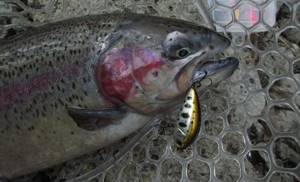
Trout wobblers are used in spinning fishing and predator fishing using a bombard float. The best options for this kind of bait are cranks, with the ability to play their own game, which is distinguished by its fine frequency and the creation of a strong vibration wave, which causes additional interest in nearby fish. Wobblers of small masses from 2 to 10 grams with bright colors, which are preferable for contrasting highlights on gray and black tones in the form of dots, are carried out on uniform movements in different water horizons, looking for promising levels of fish parking. During the period when predators are feeding from the surface of the water, small-sized poppers are ideal for fishing. Retrieving surface baits is carried out in a jerking manner.
Spinners
This type of bait is applicable in shallow waters where water levels do not exceed 3–4 meters. Mepsian pinwheels with oval petals, the Aglia type, of the smallest size are considered a classic hunting tool. By analogy, trout fishing enthusiasts select baits from other brands or make spinners of a similar type on their own. Typically, silvery petal base colors with dots of red and blue are the most catchy. The spinners are driven through the water column at medium speed, without pauses or stops, with the tool lowered to the bottom. Lake trout bite in the water column, attracted by the vibration and glimpses of the petal.
Microoscillators
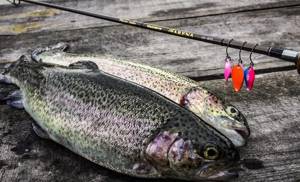
This type of spinner is no less popular than spinners, and in terms of color design, promising spinners are similar to the rotating type of spinner.
Important! The trapping tool must have a distinct point of attack.
In combinations with a spinner, flies are used that are attached to the tees of the spinner itself or launched on a separate leash next to the leading bait. An excellent example of a spinner for trout fishing is the castmaster spinner, the wiring of which is done in the water column in the form of a step in a calm and non-aggressive style. Trout spoons rarely exceed a mass of 10–12 grams and a length of 4–6 cm.
Silicone baits
Silicone simulators of all kinds of small fish, insects and aquatic inhabitants are a fairly catchy and inexpensive bait for trout. In trout fishing, silicone is used both as the main bait and as an auxiliary bait, retrofitting them into the tees of spinners. Silicone is served on stationary jig heads or in spaced equipment.
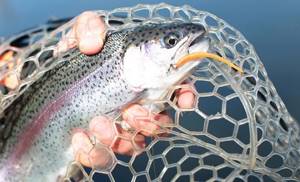
As a rule, the length of artificial fish does not exceed 5–7 cm, and vibrotails look more preferable for a predator. Slugs in the form of worms and crustaceans have also established themselves as forms of particular interest to predators. The use of edible rubber with the smell of fish oil and meat, especially in the autumn, significantly increases the number of attacks by predators. Silicone in eye-catching, unnatural colors is suitable for trout fishing. Postings are carried out using the jig fishing method, trying to make steps without the bait touching the bottom.
For trout paste
One of the innovative types of trout bait is paste. This plastic bait is made on a base of plant dough, in which manufacturers include various elements that attract trout to the fishing zone with their scents. Each manufacturer has its own recipe for preparing the composition, the ingredients of which are kept secret. Fishing practice shows that the bait can be considered universal, used in float, spinning and feeder fishing throughout the year. Fishing for trout in winter on ice from ice also cannot be done without the use of paste; choosing from a wide range of scents and colors, you can always find the key even to fish that are passive at this time of year.
Important! Trout paste is used to make balls and shapes in the form of worms and fish, which are used to equip hooks.
Incredibly distinct color schemes complement the taste appeal of the paste, making it a must-have attribute of trout hunting.
Trout fishing on paid reservoirs
- VK
Catching artificially bred trout in ponds is already becoming quite common for many anglers. The number of pond fisheries is increasing every year. The first reaction of many fishermen to such an innovation was negative: catching hungry fish (ten tons of which swim in a small pond), ready to rush at any object that falls into the water, has little in common with fishing and is more related to fishing. However, there are also more “sports” reservoirs. They contain a sufficient amount of fish, but not prohibitive, and in addition, there are natural food items (Amur sleeper, bleak, verkhovka). Content:
- FISHING PLACE
- WHERE TO FIND TROUT
- RAINBOW SEASON
- WHAT TO CATCH
- WHAT TO FISH FOR
- ROTATING SPOONS
FISHING PLACE
When choosing a place for future fishing, pay attention to the size and flow of the reservoir, as well as the water temperature. In a flowing and cool body of water, trout feel much more comfortable, therefore they bite better and behave much more actively when fishing. You should not be tempted by the low cost of the trip: most likely, there is some problem with the fish in this reservoir (maybe there is very little of it). In addition, several years ago, pond owners simply fed trout with compound feed, and the trout stopped responding to all other baits. And if the floaters and bottom fish still had some illusory chances of a bite, then the spinners had none left.
The enterprising owners simply shrugged their shoulders at the fishermen's indignation. They say, look for yourself - there are so many fish that almost wash up on the shore. And if it doesn’t bite, then that’s your problem, it means you don’t know how to catch. True, they quickly saw through the trick, and they simply stopped going to such ponds.
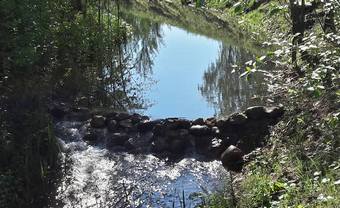
If a spinner fished well somewhere, he will certainly tell his friends (especially since this is a “pay zone” and not a hidden point on the river), and next time ten times more fishermen will come there, and accordingly the profit will be much higher - after all, they will pay not only for the ticket, but also for the fish.
Moreover, most of the owners, even during a telephone conversation, began to provide quite reliable information about the bite: for example, last spring I called a dozen “paying sites” for the sake of the experiment, and all but one (it should be noted that by that time the weather had already been very hot for a week ), I was not advised to come for trout - there is practically no bite. Only in one farm, where all ponds have a large number of bottom springs, it was reported that trout were quite active.
WHERE TO FIND TROUT
Trout in ponds usually have little attachment to vegetation or snags, of which there are few. If you carefully observe the school with polarized glasses, you can see the peculiar route along which the trout circulates along the shore. Having found several points where trout approach the shore, you can go around them one by one and systematically fish. There is another option: carefully inspect the water surface and, noticing the breakers and excitement from the school’s emergence into the surface layers of the water, immediately throw bait there (in much the same way as when catching perch or asp in a “cauldron”).
In addition, at any time of the year (but especially in the heat), trout gravitate towards the springs. If their exact topography is known and you manage to throw the bait to such a point, this is an almost 100% guarantee of a catch. Should you camouflage yourself when fishing for pond trout? Probably, such camouflage methods as when catching wild moths are not necessary, but you should not clearly stand out against the sky, especially when fishing from the bridge, make too much noise and wave your rod.
RAINBOW SEASON
Trout prefers cool and running water, so the best seasons for fishing are spring and autumn, when the water has not yet warmed up or has already cooled down. In summer you can also fish quite successfully, but it is better to focus on flowing or aerated ponds. Trout also become active during prolonged bad weather, such as long rains with cold weather. The most attractive season is spring. Since fishing with a spinning rod is prohibited during spawning in ordinary bodies of water, a spinning angler yearning for fishing has only two options: either deliberately break the law and fish with a spinning rod on a river or lake, or go to a “pay zone” where there are no prohibitions.
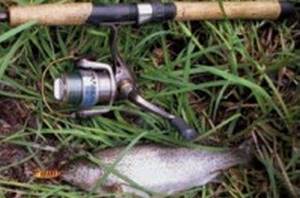
WHAT TO CATCH
Trout is a very lively and strong fish. However, you should not deprive yourself of pleasure and choose overly powerful gear. In my opinion, on a small body of water it is quite enough to use a light class rod. And only on large lakes do you have to take a longer “stick”, since trout often concentrate at a distance of 50-60 m from the shore and you can’t reach it with a short rod. The reel is also small, the optimal size is 2000 according to the Japanese classification, for example Ryoby Zauber. The choice of fishing line is a matter of taste. Fishing for trout does not require its hyper-sensitivity, such as fishing with jig baits, so the use of multifilament lines is completely unnecessary. However, I prefer thin “braid” with a tensile strength of up to 5-6 kg. In combination with a rod with a moderate or slow action, the number of trout catches is no more than when using a monofilament. Many spinning anglers claim that trout are afraid of braided line, but I have never received reliable confirmation of this fact, even when fishing with bright red or yellow “braid”. Nevertheless, in this situation it is quite possible to use “braid” of faded tones - the visibility of the cord does not play a big role, since the bite is quite felt by hand, and control of the wiring is, as a rule, simple. Naturally, no leashes are required if there is no pike in the pond.
WHAT TO FISH FOR
Having tried almost the entire arsenal of a wide variety of baits, I settled on a few that help me out in almost any situation and on any body of water. Wobblers. Trout bite on wobblers of any class and type, but minnow and rattlin seem to me to be the best and most convenient. My observations show that, even when trout are predominantly in the surface layer of water, they respond better to baits going at a depth of 4050 cm. Therefore, sinking minnows and suspenders are more suitable (and such baits fly further when cast). Don’t get carried away with too large wobblers; a reasonable maximum is 80-85 mm. The one I use most often is the Masu Masters MM 58; River2Sea Valor 75 and Sock 85; C'ultiva Rippi'N'Minnow RM 70. If the original is a floating model, then it is worth replacing the tees on it with slightly larger ones, then the trout will be better hooked, and the wobbler will become sinking. It is worth noting that it is minnow wobblers that are the “record holders” for catching trout. It happens that for a couple of “correctly” caught trout, three or four are caught with their belly or tail. Taking this into account, many spinning anglers generally refuse to use jerk baits on hotbeds, despite their high catchability.
Since almost all of the listed wobblers are deprived of their own game, the only method of their animation is jerking, most often twitching. It is absolutely impossible to plan the “aggressiveness” of the wiring (that is, the strength and amplitude of the jerks). It happens that trout react only to sluggish movements of the wobbler, and sometimes, on the contrary, they clearly prefer frequent and sweeping jerks, as if when fishing with jerkbaits. Therefore, I cannot say that there is any type of preferred jerk for pond trout. Each time you have to select it according to the “mood” of the fish.
Any other methods of wiring, as well as other baits during such a “spinning wilderness” turned out to be ineffective. Pond trout in most situations clearly prefer wobblers of bright, “acid” colors. I don’t presume to judge what’s going on here. Perhaps bright orange, red and green colors have some special appeal to the trout's vision. In the last two years I have been fishing for trout almost exclusively with acid baits. This does not mean that it is not caught at all with baits of natural colors, however, in most situations, my catches are clearly better with baits of bright colors. Moreover, this applies to wobblers, oscillating and rotating spoons. A safe rattlin-type wobbler is a bait that, in my opinion, should definitely be in the arsenal of every spinner, especially if he is going to fish for trout in a large body of water. The rumble of such a bait can attract fish from a very long distance, especially when fishing in clear water. As soon as you cast the rattlin and start retrieving, curious trout begin to swim towards it from a distance of 10-15 m; they poke their noses at him, accompany him, then he suddenly disappears, and the rod bends into an arc.
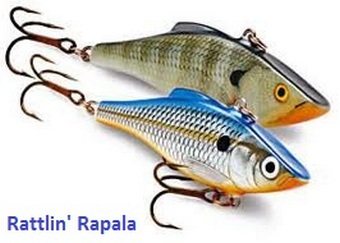
The wiring required is the simplest - uniform, at a depth of about 0.5-1 m. The speed must be selected so that the bait goes at the desired depth, without sinking or coming to the surface. To do this you need to have rattlin'bi of different masses. Sometimes this technique works: after casting 11.5 m, the wobbler is driven evenly, and then the wiring is stopped, and the rattlin begins to sink. As a rule, a bite follows after a second or two. Most often I use A-elita Vib (7 and 21 g); Berkley Frenzy and Masu Masters MM Vib 38 (this miniature wobbler in the “noise” version is a real “magic wand”: even with the worst bite, you can always “force” one or two tails on it). The Vib 38 has two drawbacks - small tees and a small mass, which limits casting range, but basically it is, in my opinion, an ideal bait for “wise” trout.
ROTATING SPOONS
My favorites are bright and compact lures. There are no special requirements for “turntables”, other than ease and stability of rotation at the lowest wiring speeds. Most often I fish with Vibrax, Heron and Mosca Graffy (the best color is bright orange with black stripes). Spinner baits are good because they allow a slow retrieve, which trout often like.
Another advantage is that with “spinners” you can use various attractants, to which trout are far from indifferent. I have long preferred the Mega Strike - the trout like it and it holds well on the lure. It is best to apply the attractant to the edge of the tee. But the best option is to use special spinners adapted for the use of attractants.
Berkley has a whole line of ScentVent spinners, which have a core made in the form of a plastic lattice; the gel-like Mega Strike stays on it very reliably, and one “fill” is enough for several fishing trips. One such spinner with a rainbow petal, treated with Mega Strike, regularly seduced trout for a week on one of the paid reservoirs within Moscow against the backdrop of a total lack of biting, and the fish ignored all other baits, only occasionally falling for a float rod with corn and shrimp attached.
With wobblers and spinners in the box, you can consider yourself fully equipped to go to the trout pond. However, the trout does not miss and very willingly bites on oscillating spoons (usually small in size; Kamlooper from Acme shows very good results), jig baits (twisters, rippers, etc.), which are best not led along the very bottom, like, say, when fishing for pike perch, but half-water. Trout can also be caught in the bottom layer, but mid-water bites occur much more often.
Another type of lure that trout like is bladebaits. Lures, frankly speaking, are not for everyone, but it would be unfair not to mention them, especially since I catch trout with them at least half the time. Their wiring is the same as rattlin class wobblers - uniform or slightly wavy in the surface layer or at half-water. Despite the fact that the vast majority of lures of this type do not have acoustic elements (with the exception of Sonara and Flappin' Sonic), trout clearly focus on bladebaits and actively attack them. The big advantage of bladebaits is that they have several holes for attaching fishing line (by simply rearranging you can radically change the frequency and amplitude of their oscillations without changing the speed of the retrieve), as well as their compactness, which significantly increases the casting distance.
Out of quite a large number of different models, I mainly use three: this is the old DAM model (clone of the American Gay Blade) and the Japanese ones - Little Max (Evergreen) and my favorite - Flappin' Sonic (Imakatsu). The latter has a metal tail, which has not only a decorative function: if you remove it, the fish begins to bite worse (and not only trout, but also perch). However, both “Japanese” ones need a little tuning if you are going to catch trout with them.
In the original version, both bladebaits are equipped with double hooks with stings pointing backwards, which reduces the number of hooks, but these hooks hook trout poorly and unreliably. We fish in half-water, so we don’t have to think about hooks, but the slips are very frustrating, so we replace double hooks with small treble hooks - this doesn’t affect the performance of the bait in any way, and the number of empty hooks and slips is reduced by an order of magnitude.
A FEW LITTLE THINGS
Trout are severely injured when fishing, so the vast majority of reservoir owners prohibit releasing caught fish back. Therefore, you will have to take care of the safety of the trophy.
After catching, you must immediately euthanize the trout (a fishtoter, or priest - a stick with a special knob, will help you do this), and then it is better to gut it and put it in a cool place (for example, in a car refrigerator or a thermal container with cold batteries). There it won’t freeze, but it won’t spoil either; and when you arrive home, it’s better to immediately prepare your trophy - the most delicious trout is chilled, not frozen.
Related articles:
Spring fishing
Catching catfish using kwok
Methods of fishing with bottom rigs
Catching perch with light bait. Microjig
What do they use to catch trout on paid sites?
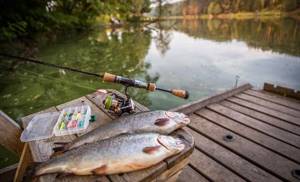
Paid fishing for trout, mostly in stagnant reservoirs and in conditions of comfortably equipped coastlines, is carried out using spinning and float fishing during the period of open water and for winter girders and winter spinning from ice. The rules of paid ponds only in rare cases allow hunting a predator using live bait and animal baits, and for the most part fishing on ponds is carried out only with artificial baits. The most common are rotating and oscillating spoons, silicone and wobblers, as well as trout pastes. When visiting the same body of water, fish preferences become noticeable in terms of responsiveness to a particular bait and its color design, which should definitely be taken into account in strategies for this body of water when planning future fishing trips.
Bait recipe
On stagnant and weakly flowing reservoirs, it is important to use bait for trout, which is mandatory when fishing with a feeder and obviously does not hurt when hunting with float gear. Bait helps to further attract fish to the fishing zones. Fishing stores sell special mixtures for trout, but knowing the principles of bait formation and its basic fish-attracting properties, the mixture can easily be made independently at home. The basis of the bait is fishmeal with trout pellets. An attractant with the smell of shrimp, squid or fish oil is added to the ingredients mixed in equal quantities.
The secret of trout mixtures is the presence in the mix of substances that cause geyser effects, with the release of nutrient particles at certain intervals into the water column and bright dyes. Geysers are special components sold in fishing nets as additives to bait. If you regularly feed a certain place with this kind of mixture, the trout will stay close to the point and react to any given bait not only if they want to eat it, but also by reflexive actions of protecting a territory that is favorable in terms of nutrition.
Trout fishing: the best baits and lures
To catch large trout in a short time, it is best to use a paste based on natural and artificial substances. It has a bright aroma and quickly attracts fish. Special formulations are sold in fishing stores at an affordable price (about 200 rubles per jar). They have several advantages:
- bright aroma;
- saturated color;
- the presence of sparkles that create the effect of caviar or scales (not always);
- low consumption at low cost.
Even a novice fisherman will understand how to properly catch trout using paste. A plasticine-like material is simply formed into a ball and placed on a hook.

